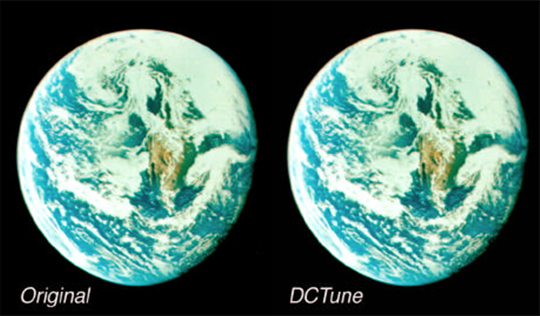|
|
 |

|
 |
 |
| DCTune- Perceptual Image Compression Prototype (Andrew B. Watson, & John Mcgowan) |
 |
NASA missions have and will continue to generate immense quantities of image data. For example, the Earth Observing System (EOS) was expected to generate in excess of one terabyte/day. NASA confronted a major technical challenge in managing this great flow of imagery: in collection, pre-processing, transmission to earth, archiving, and distribution to scientists at remote locations. Expected requirements in most of these areas clearly exceeded current technology. Part of the solution to this problem lied in efficient image compression techniques. As part of a larger program of human factors research, Ames has developed technology to improve image compression.
For much of this imagery, the ultimate consumer is the human eye. In this case image compression should be designed to match the visual capacities of the human observer. Ames has developed technology, called DCTune, for perceptual optimization of image compression, based on a model of human vision. DCTune technology is compatible with JPEG (Joint Photographic Experts Group), the current international standard for still image compression. Two patents have been awarded for DCTune technology.
DCTune calculates the best JPEG quantization matrices to achieve the maximum possible compression for a specified perceptual error, given a particular image and a particular set of viewing conditions. In DCTune, a target perceptual error of 1.0 means that for the specified viewing conditions the compressed JPEG image is perceptually lossless, that is, it will appear exactly the same as the original uncompressed image.
DCTune offers three key benefits:
- Accurate specification of visual quality. DCTune incorporates a scale that relates directly to perceptual quality. A value of 1 indicates perceptually lossless quality.
- Custom quantization matrices optimized for specific applications (printing, internet, web- TV, medical imaging, TV, digital video disks (DVD), digital video camcorders (DV), digital TV, high-definition TV (HDTV), teleconferencing, etc).
- Reduced file size. For a given level of visual quality, DCTune will produce a smaller file than standard JPEG.
To expedite transfer of this NASA technology to the commercial sector, we have developed a prototype application and made it available to potential developers. DCTune1.1 is a minimal implementation of DCTune technology that is offered free for demonstration purposes only. It takes a color image, computes the optimal quantization matrix, and generates both the matrix and the compressed image.
The figure shows an original image (left) and the same image after compression using the DCTune prototype. The amount of compression was selected so that original and compressed images would be indistinguishable.

Figure 1. An original image and the image resulting from application of DCTune perceptually optimized image compression. The image on the right has been compressed as much as possible while still ensuring that it is visually indistinguishable from the image on the left. |
|
|
|
|